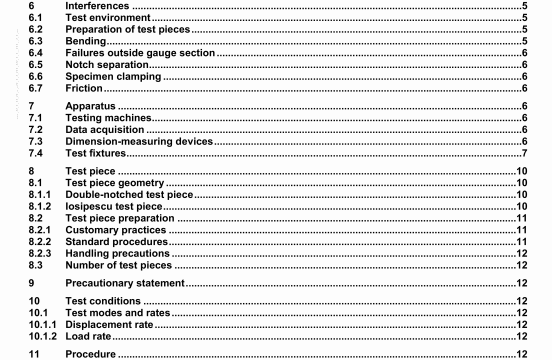ISO 20505 pdf download – Fine ceramics (advanced ceramics, advanced technical ceramics)一 Determination of the interlaminar shear strength of continuous-fibre-reinforced composites at ambient temperature by the compression of double-notched test pieces and by the losipescu test.
8.3 Number of test pieces
A minimum of S valid test results Is required for the purpose of estimating a mean value A greater number of
tests may be necessary, if estimates regarding the form of the strength distribution are required 9 Precautionary statement
During the conduct of this test method, the possibility of ftying fragments of broken test material may be high The bflttle nature of advanced ceramics and the release of strain energy contflbute to the potential release of uncontrolled fragments upon fracture Means for containment and retention of these fragments for later fractographic reconstruction and analysis Is highly recommended.
WARNING — Exposed fibres at the edges of contlnuous-tibre.relnforced ceramic composite test pieces present a hazard due to the sharpness and brittleness of the ceramic fibres. All persons required to handle these materials must be well informed of these conditions and the proper handling techniques.
10 Test conditions
10.1 Test modes and rates
Test modes may involve load or displacement control. Recommended rates of testing shall be sufficiently rapid to obtain the maximum possible shear strength at fracture of the material within 30 a. However, rates other than those recommended here may be used to evaluate rate effects In all cases, the test mode and rate shall be reported.
Generally, displacement-controlled tests are employed in such cumulative damage or yielding deformation processes to prevent a runawaj condition (i.e. rapid uncontrolled deformation and fracture) characteristic of load- or slress-controled tests. However, for sufficiently rapid test rates, differences in the fracture process may not be noticeable and any of these test modes may be appropnate.
10.1.1 DIsplacement rate
Use a constant aoss-head displacement rate of 0.05 mm/s. unless otherwise found acceptable as determined
under the conditions specified in 10,1.2.
10.1.2 Load rate
Select a constant loading rate to produce final fracture in 10 s to 30s, or to be approximately equivalent to a test rate of 0.05 mm/s.
11 Procedure
11.1 Test piece dimensions
For doubie-notched test pieces, determine the thickness and width of the gauge section of each test piece to within 0,02 mm, Avoid damaging the critical gauge-section area by performing these measurements, either optically (e.g using an optical conparator) or mechanically using a flat, anvil-type micrometer.
In 1998-1999, the US Depariment of Energy and the US Air Force sponsored a round-robin testing program to determine the precision and bias of ASTM Standard Test Method C1292. The repeatability and reproducibility were assessed for the inlertaminar sheer strength based on the results from the evaluation of 10 specimens by seven laboratories. Bias was not evaluated because there is no commonly recognized standard reference material for continuous-fibre-reinforced ceramic composites.
Interlaminar shear specimens were 30 mm long, 15mm wide, and had a nominal thickness of 3mm. The nominal notch separation was 6 mm. The specimens were diamond-gnt cut from three panels of a commercial Sylramic S20W ceramic composite. The notches were machined In several passes and had a nominal width & 0,05 mm and a nominal depth of 1.5 mm. The panels were fabricated with eight plies of ceramic grade Nicalon1) fabric (B-harness satin weave) coated with baron nitride and embedded ii a potymer-derived siliconcarton ,tride matrix. The matenal had a nominal fibre volume fraction of 45 %. a mean bulk density of 2,21 g/cm3. and average open porosity of 2,7 %.
Round-robin participants were required to perform interlaminar shear strength tests in accordance with (21292. Tests were conducted at a constant cross-head displacement rate of 0,05 mmis.
ISO 20505 pdf download – Fine ceramics (advanced ceramics, advanced technical ceramics)一 Determination of the interlaminar shear strength of continuous-fibre-reinforced composites at ambient temperature by the compression of double-notched test pieces and by the losipescu test
